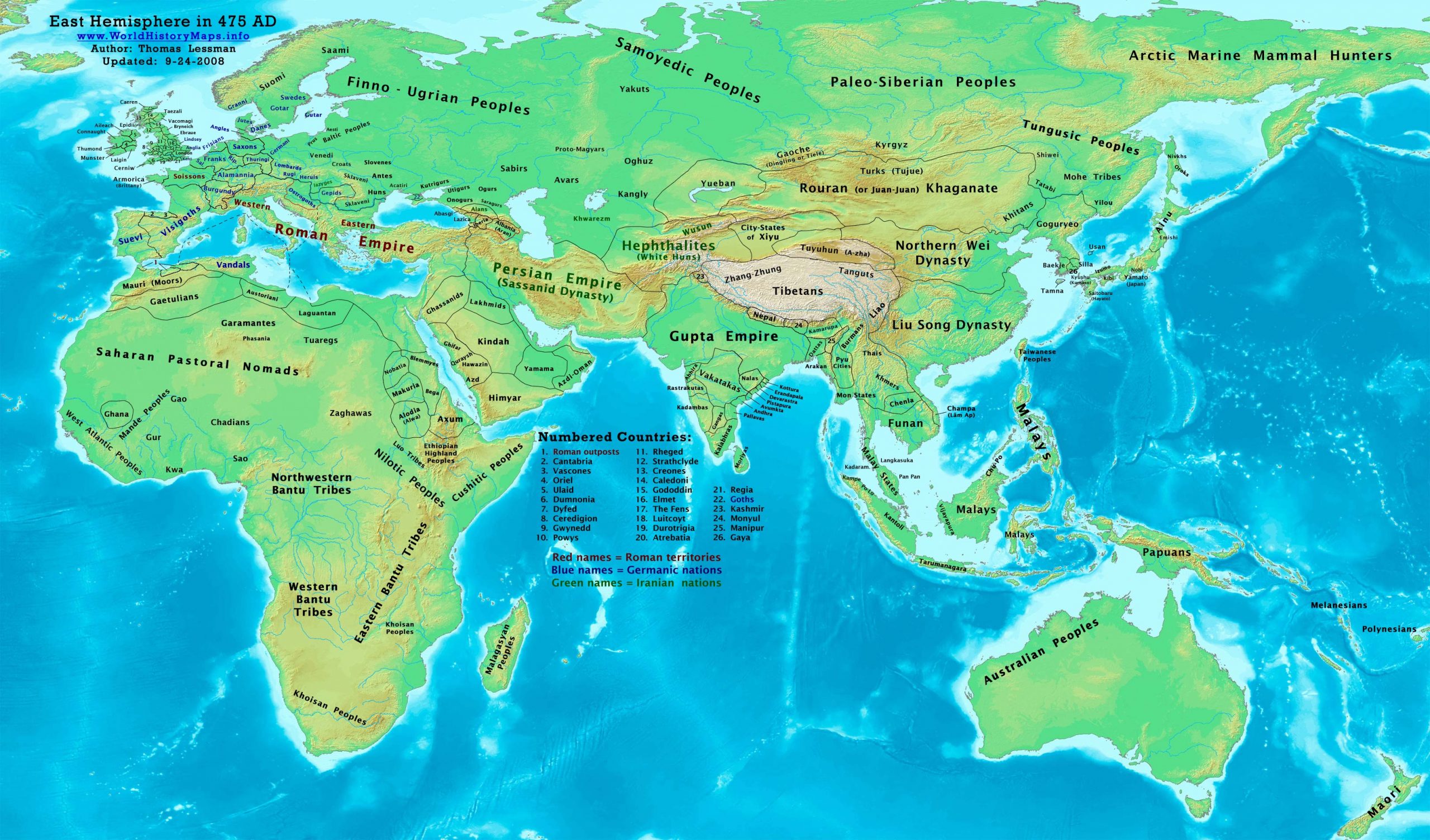https://www.worldhistorymaps.info/wp-content/uploads/2021/03/map-475ad.jpg
Primary Sources for East-Hem_475ad.jpg:
- The DK Atlas of World History, 2000 edition. (See specific references below)
- John Nelson. Interactive Historical Atlas of the World since 500BCE. Map of “Countries of the World 1/1/400 CE.”
World History Maps Inc., Alexandria, VA, 2008. Available at www.WorldHistoryMaps.com.
- Denis Bellemare. Historical Atlas of Late Antiquity. See specific references below.
- Euratlas. Periodical Historical Atlas of Europe. Map of “Europe in 500 AD”.
Euratlas-Nüssli, rue du Milieu 30, 1400 Yverdon-les-Bains, Switzerland
- User:Javierfv1212. Map of the “The_world_in_500_CE.PNG”. Available on Wikipedia.
I – African information:
* African Tribal locations are derived from:
- The DK Atlas of World History. Map of “Development of Complex Societies in Africa”. Pg 160.
(Bantus, Berbers, Chadians, Cushites, Garamantes, Gur, Khoisans, Mandes, Nilotics, West Atlantic Peoples, etc.)
- User:Javierfv1212. Map of the “The_world_in_500_CE.PNG”. Available on Wikipedia
* North African borders are derived mostly from:
- Denis Bellemare.Historical Atlas of Late Antiquity. Maps of “NW Africa in 460 AD” and “NE Africa in 460 AD”.
II – Asian information:
* Greater India (Including modern Bangladesh, India, and Pakistan):
- John Nelson. Interactive Historical Atlas of the World. Map of the “Countries of the World 1/1/475 CE.”
- Joseph Schwartzberg. The Historical Atlas of South Asia. Map of “The Gupta-Vakataka Age, c. A.D. 300-500“
* Hephthalite borders are derived from a combination of:
- North borders: History & Commercial Atlas of China. Map of “South Ch’i & North Wei Dynasties in 500 AD”.
- East borders: Interactive Historical Atlas of the World. Map of “Countries of the World 1/1/475 CE”.
* Japanese Islands :
- The DK Atlas of World History. Map of “State Formation in Korea & Japan to 650 CE”. Pg 264.
* Korean & Manchurian information:
- Park Hyeon. Map of “History_of_Korea_300_BC.png”. Available on Wikipedia.
III – European information:
* British Isles information is from:
- David Nash Ford. Early British Kingdoms. Map of “Britain in 475 AD”.
* European borders are derived from a comparrison to these maps:
- Euratlas. Periodical Historical Atlas of Europe. Map of “Europe in 500 AD”.
- Denis Bellemare. Historical Atlas of Late Antiquity. Comparrison of: a – Maps of “West Europe in 460 AD” and “East Europe in 460 AD”. b – Maps of “West Europe in 500 AD” and “East Europe in 500 AD” .
IV – Australia, Siberia, & Other Fringe Areas
Note: Fringe information is derived from comparisons of these sources:
- The DK Atlas of World History, 2000 edition. Map of “The World in 500 CE”. Pgs 50-51.
- User:Javierfv1212. Map of the “The_world_in_500_CE.PNG”. Available on Wikipedia.
Note: Much of the information in this map was cross-checked with Bruce Gordon’s Regnal Chronologies.
Roman Empire
- January 9 – Emperor Zeno abdicates under pressure, as his wife’s uncle Basiliscus stages a coup d’état at Constantinople, with support from Zeno’s trusted adviser and fellow Isaurian Illus. Basiliscus usurps the throne and is proclaimed new emperor (Augustus) of the Eastern Roman Empire. He begins a 20-month reign; Zeno and his supporters flee to Isauria.
- April 9 – Basiliscus issues a circular letter (Enkyklikon) to the bishops of his empire, promoting the Miaphysite christological position. These religious views will make him highly unpopular.
- Summer – Emperor Julius Nepos grants the Visigoth King Euric legal tenure of his conquests, which include Provence (region of Gaul), in exchange for full independence.
- August 28 – Magister Militum Orestes takes control of the government in Ravenna, and forces Julius Nepos to flee to Dalmatia.
- October 31 – Romulus Augustus is installed as emperor by his father Orestes, who becomes regent in effect of the Western Roman Empire. Augustus will ultimately rule for 9 months, as the last emperor of the Western Empire.
Asia
- Bodhidharma, Buddhist monk, travels to China and, begins teaching the Laṅkāvatāra Sūtra (approximate date).
- Gongju becomes the capital of Baekje, and is threatened by Goguryeo, who conquers the Han River valley (Korea).
- Munju becomes king of Baekje.
Byzantine Empire
- Great fire in Constantinople with loss of Palace of Lausus and – along with it – the famous Zeus from Olympia.
Source: Wikipedia

